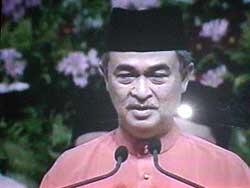United Malays National Organisation
|
|
The United Malays National Organisation, or UMNO, (Malay: Pertubuhan Kebangsaan Melayu Bersatu), is the largest political party in Malaysia and a founding member of the Barisan Nasional coalition, which has ruled the country uninterruptedly since its independence.
| Contents |
Formation
After the British returned to Malaya in the aftermath of World War II, the independence movement started to take wing to oppose the British plan of a Malayan Union. A series of Malay congresses were held, culminating in the formation of UMNO on May 11, 1946 at the Third Malay Congress in Johor Bahru, with Datuk Onn Jaafar at its head.
UMNO_logo.gif
However, membership in UMNO was and continues to be limited to members of the Malay (bumiputra) race, and Onn Jaafar's attempt to change this policy and the party's name into the United Malaya National Organisation was rejected in 1951. Onn Jaafar resigned in protest, but his role was taken up by Tunku Abdul Rahman who steered the country to independence in 1957.
Independent Malaysia
In the 1959 general elections, Malaysia's first, the Alliance coalition led by UMNO won 51.8% of the votes, resulting in 74 out of 104 seats, enough for an absolute two-thirds majority. The Alliance (now known as the Barisan Nasional) has maintained this majority ever since, with the notable exception of the 1969 elections where the Alliance's share dropped to 45%, resulting in the racial riots known euphemistically as the May 13 Incident.
After the separation and independence of Singapore in 1965, the Singapore branch of UMNO was renamed the Singapore Malay National Organisation (Pertubuhan Kebangsaan Melayu Singapura).
UMNO's share of votes has steadily declined since Islamic party PAS's emergence onto the political scene in the 1990 general elections.
In the 1999 general election, rocked by the arrest and trial of former UMNO deputy Anwar Ibrahim and the subsequence formation of the Barisan Alternatif opposition coalition, UMNO's share dipped to 54% of the vote and 102 out of 144 seats despite allegations of vote-rigging.
The replacement of UMNO with UMNO Baru (New UMNO)
On 24 April, 1987, United Malays National Organisation (UMNO) held its Annual General Assembly and triennial Party election. The Prime Minister, (Then) Datuk Seri Dr. Mahathir Mohamad, faced his first party election in 12 years, having been regularly promoted through patronage and internal party arrangements (which really meant being elected unopposed), after the 1975 UMNO election.
The politics of the Malays, particularly UMNO politics, had undergone a sea change in the few years of the Mahathir stewardship, and the incumbent party president was challenged for the second time in 41 years. The first challenge had been a dull affair in which Datuk (now Tun) Hussein Onn had been opposed by a minor party official named Sulaiman Palestin. (Another President, Tunku Abdul Rahman had also been challenged by one C. M. Yusof, (later Tan Sri and Speaker of the Lower House) in the early 1950s but the Tunku was then only the care-taker President, not properly the incumbent.)
The 1987 contest was a vastly different matter. Dr. Mahathir was opposed by his very popular former Finance Minister, Tengku Razaleigh Hamzah.
In the event, Dr. Mahathir was returned to office after a long, intense, not to say vicious campaign, as President. But it was with such a minuscule majority that there were immediate questions about the value, not to say validity, of his mandate.
Dr. Mahathir had not only barely scraped in, defeating his opponent, Tengku Razaleigh with a majority of 43 (761 against 718 votes), but there were now allegations that several delegates who had voted were drawn from UMNO branches not properly registered under The Societies Act, 1966. There were also several unproved allegations being bandied about that the balloting process had not been above board.
On 25 June, 1987, an appeal was filed by 12 of the UMNO delegates (one of whom, Encik Hussain bin Manap, withdrew unexpectedly in August) to have the assembly and the election of April 1987 declared null. The remaining litigants have since become famous as the "UMNO 11."
After a series of interlocutory hearings over the discovery of documents - and that took more than seven months - the matter finally came before Justice Harun Hashim in the Kuala Lumpur High Court, on 4 February, 1988.
The judge then ruled that under the existing law he had no option but to find the party, UMNO, to be an unlawful society. The question of the Assembly itself being illegal therefore became academic.
"'It is a very hard decision to declare UMNO unlawful,' said Justice Datuk Harun Hashim in his 4 February judgement. 'But the law was made by our Parliament and certainly UMNO was aware [of the Societies Act] because they were in the majority [in Parliament] at all times [when the law was made].' Under the 1966 Act, amended five times over the years, and most recently by Mahathir’s government, each of the society's branches has to register separately with the Registrar...."
Dr. Mahathir, showed no interest in reviving his party as he did not . Instead he set in motion the machinery to form a new surrogate party, and in due course, registered a party formally called Pertubuhan Kebangsaan Melayu Bersatu (Baru) or UMNO (New). Tungku and Hussein Onn refused to join UMNO Baru until they died.
See also
External links
- UMNO website (http://www.umno-online.com/)
- http://www.geocities.com/CapitolHill/Congress/5544/mayday7.htm


